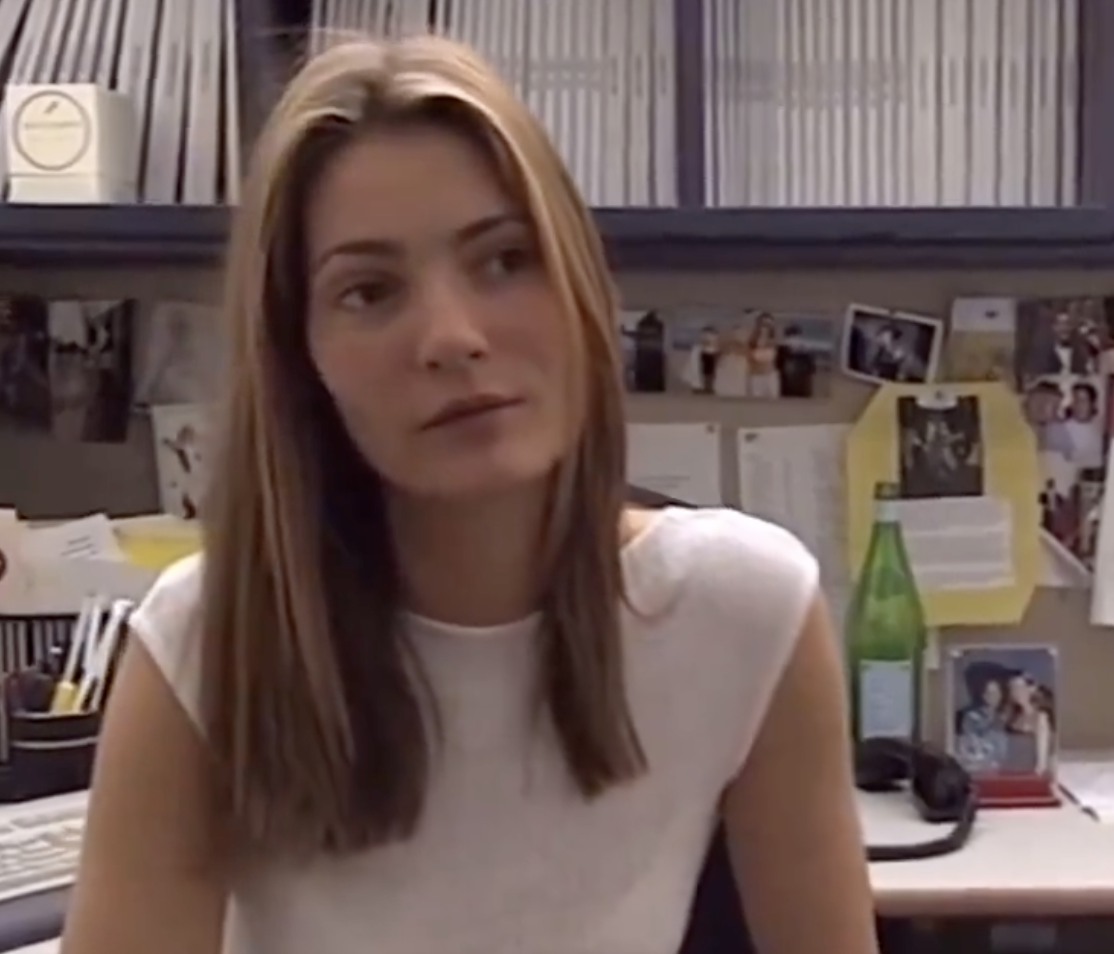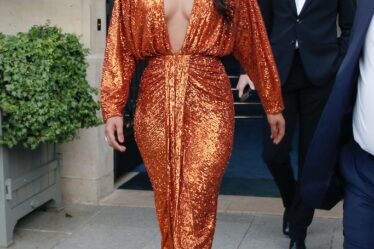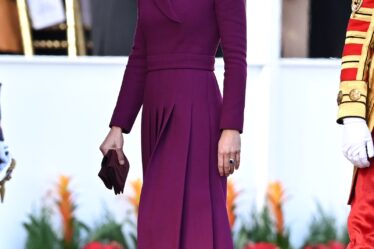
Who is Plum Sykes? A lot of people want to know after a clip of the writer from the 2000 docuseries Boss Women: Anna Wintour went viral on Twitter earlier this week. In it, Sykes, a Vogue staffer dressed in a t-shirt and midi skirt, tells the camera, “The clothes that people wear here in the day are probably clothes that normal people would wear on their most glamorous night out of the year.” Of course, her outfit doesn’t seem very remarkable today, but back then, Sykes says, it was kind of revolutionary. To learn more, our senior editor Taylore Scarabelli jumped on a Zoom call with the British fashionista turned best-selling fiction author to talk personal style, Substack, and The Devil Wears Prada.
———
TAYLORE SCARABELLI: Hello?
PLUM SYKES: Hi, Taylore.
SCARABELLI: Hi. Thanks for jumping on. Are you in New York?
SYKES: No. I’m in my house in England.
SCARABELLI: Oh, lovely.
SYKES: I live in the English countryside. I’m literally in my riding clothes. I went out riding this morning and then I’ve been at my desk the entire day writing a story for Architectural Digest. Then I was on Zoom calls and I was like, “Oh my god, I haven’t changed.”
SCARABELLI: That sounds like a perfect day.
SYKES: Thank you. Well, listen, let’s get on, because I’ve got to do another Zoom at 3:30. Should we talk about the mad video first?
SCARABELLI: Yes. So you went viral for this clip from a documentary called Boss Women. You’re basically wearing a tiny white shirt, like I’m wearing, and—
SYKES: Which I think was from Dolce & Gabbana as well. I think I bought the shirt and the skirt at a Dolce & Gabbana sample sale because I obviously couldn’t afford to shop in the shops, and I still can’t.
SCARABELLI: Right.
SYKES: I wore that white top all the time, and I wore the chiffon skirt all the time. But the crucial thing about the chiffon skirt—I wish I still had it—it had stretch in it. So it was sheer, which was very ’90s, but it was quite easy to wear. It wasn’t really like wearing an evening thing. But by the way, that video has been viral on TikTok for a long time now.
SCARABELLI: I know. It’s gone viral again on X.
SYKES: I don’t even really know what it means to go viral. Is it just like, lots of people comment on it?
SCARABELLI: Well, yeah, I guess there’s some reaction. Because you say something like, “Only somebody who works at Vogue would wear this outfit to the office,” one comment that really went around was, “I’d wear this to the post office.”
SYKES: Oh, that’s so funny. Good for them.
SCARABELLI: So my question is, what was office dressing like back then, and why did you feel that outfit was special?
SYKES: It’s funny because I know that in retrospect, that outfit doesn’t look very exciting. But at the time, this is ’97 or ’98, most people were still coming out of ’80s office dressing—think about the Donna Karen ad of the girl in the blue blazer with the gold buttons standing by the presidential desk. So people were wearing very bad versions of Ralph Lauren suiting, Donna Karen suiting. They were basically wearing ill-fitting navy blue skirt suits to work. So what we wore to work at Vogue looked very Bohemian and fun in comparison. Obviously I wore all sorts of things to work. Actually, working at Vogue, the whole point was to wear interesting clothes. I used to go to work wearing a 1930s night dress that I’d bought in Portobello Market with flip-flops, and I would put a big silk rose in my hair, and I thought that was completely normal. My other favorite thing was a mini dress that was literally just hid my butt.
SCARABELLI: Wow.
SYKES: And high heels.
SCARABELLI: That sounds crazy to people now who have this idea that Anna Wintour is very strict about dressing.
SYKES: I don’t think she’s very strict about dressing. She likes people who are original. If you had a whole load of Vogue staffers who all looked the same, were all in a Helmut Lang suit, whatever, it would be really boring for her. She actually was hiring people to take inspiration from. I remember once one of the editors coming up to me, I don’t know whether it was Tonne [Goodman] or one of them, and saying, “Anna says she wants skirts like the ones Plum wears.”
SCARABELLI: [Laughs]
SYKES: I think I was wearing a long Missoni vintage knitted skirt, like a geek chic thing. And I thought, oh, that’s so interesting, because it is what’s around you that inspires you. And obviously I was 20 something, I was at the cutting edge of what you should want to wear, but it wasn’t designer clothes. It was what I’d thrown together from the thrift stores and the markets and a bit of sample sales and all of that. It wasn’t all about brands and labels and logos at that time. It was much more undone. And if you think about the iconic Vogue people, André Leon Talley, Hamish [Bowles], Camilla Nickerson, they all dress in very, very distinct ways that are entirely them. They’re not sticking to the mold. They’re the opposite. And Anna loved all of that.
SCARABELLI: That’s true, but she called you, “The quintessential Vogue girl.”
SYKES: Oh, yeah.
SCARABELLI: How did you start working at Vogue?
SYKES: I started in London as Isabella Blow’s intern, that was really good fun. I was about 22 or something. Then I became a fashion writer at British Vogue, like a junior, the lowest of the low. And then I was hired by Anna to be a fashion writer at American Vogue. I was never Anna’s assistant, but people think that because because there was an English actress playing Anna Wintour’s assistant in The Devil Wears Prada. I was working at Vogue when Lauren Weisberger [the Author of The Devil Wears Prada] was there, and I have an English accent, but that’s—
SCARABELLI: Do you think that character was inspired by you at all?
SYKES: Well, I’ve never thrown a fire coat at anyone on their desk. Do you know what I mean?
SCARABELLI: Yeah.
SYKES: But I’ve never asked Lauren. I must ask her, actually. But I think the Emily character was so mean that she was probably an amalgam of all the worst things that people have said about each other at Vogue. Because I do remember that people could be pretty judgmental about the other girls.
SCARABELLI: So when you started as a junior writer, you were also modeling, right?
SYKES: Well, I was working at Vogue, and I was very good friends with people like Alexander McQueen and quite a few photographers like Tim Walker, and they would say to me, “Could you model in my show? Because I can’t afford any models.” Or, “Could I do some pictures of you?” I wasn’t doing it as a job. I was literally just doing it for a laugh on the side. I did get some really amazing pictures shot by Steven Meisel, which was really cool. But again, that was just because I was Izzy’s assistant, and he was like, “We want to have Plum in the pictures.”
SCARABELLI: Fab.
SYKES: To be honest, I found all of that extremely embarrassing because I used to think, “Am I the fashion assistant or am I in the shoot?” But it was really fun. When I walked in a Prada show, it was amazing to be backstage with all those models, to meet all those incredible hair and makeup people. And because of modeling, I had a way into fashion journalism that others didn’t. I knew what it was like to be a model. I knew what a nightmare it was.
SCARABELLI: I also think it’s interesting when thinking about the media landscape right now. Influencers are becoming editors and vice versa. The pressure to be front-facing is really intense right now, it’s just part of the job. So I was thinking about you falling into modeling back then, you say you were a little bit embarrassed by it, but do you think it helped your career at all? Isn’t it a good thing to be on the runway at Prada?
SYKES: I’ve never really thought about whether it helped me or not. I met a lot of people in the fashion business, so my contacts were massively broad because of it, but I don’t think having my face in the pages of Vogue—I mean, I don’t know, maybe. It probably did help actually.
SCARABELLI: I mean, you were an “it” girl.
SYKES: I couldn’t really quantify it, but I also think that if I’d been a shitty writer, it wouldn’t have helped having my picture in a magazine. Luckily, I was quite good at the writing, and I worked really hard. It all goes hand in hand.
SCARABELLI: Of course, and it’s interesting because now everyone’s got to do both.
SYKES: Then it was the opposite. When Alexander [McQueen] said to me, “Will you please be in the Highland Rape show?” I said, “This is a step too far. I’m a fashion journalist. I’m not doing this.” There was no way.
SCARABELLI: Well, I just modeled in my first show and I wore a jockstrap. [Laughs]
SYKES: Oh my god, you are so brave. Whose show was that?
SCARABELLI: It’s this young designer in New York called Shame.
SYKES: Shame?
SCARABELLI: [Laughs] Shame. Yeah.
SYKES: Oh, that’s so funny.
SCARABELLI: It was corporate on the top, jockstrap on the bottom. It was really fun. And I agree with what you were saying earlier. To have that day being behind the scenes definitely reinvigorated me as an editor.
SYKES: That’s the thing. It is fun. It’s all part of the rich tapestry of fashion.
SCARABELLI: Absolutely. So you’ve done a lot of great fiction projects and you’re still writing for magazines, but the media landscape has changed drastically since you started your career. What are the biggest challenges for you as a writer?
SYKES: It’s funny, I was talking to my agent about this yesterday, about how there is no longer a monoculture, which is great for the consumer in some ways, but it makes it very difficult to have a business model that works for the writers, the publishers, the editors, et cetera. It used to be just the New York Times, Vogue, Vanity Fair, the Washington Post, the Wall Street Journal—as long as you had one of those for your book, you were set. And now there’s Substack, there’s Instagram, there’s all these different channels.
SCARABELLI: Yeah.
SYKES: It seems to be that the monoculture is too simplistic now, and that people are much more sophisticated in what they want. They want a very personal view of how to live their life. And I look at, for example, Leandra Medine. Her Substack is absolutely brilliant. It’s so unique. It’s so personal. She wouldn’t be allowed to write that in a magazine or a newspaper. No way.
SCARABELLI: Well, it’s interesting because even with cultural critique, it’s hard to make generalizations about what’s in or out. That’s also why personal writing is so relevant right now, because there isn’t really another way to comment on culture. Everything is so fractured.
SYKES: I remember at the end of the ’90s, we had this section in Vogue which was devoted to personal style because all the big trends had started to break down. No one was interested in saying everyone was wearing a miniskirt. And today it’s all about your personal point of view. We want to know about it from certain people in the culture, and they can’t do that in magazines and newspapers because of the advertising business model, but they can do it on other platforms.
SCARABELLI: Absolutely. But then there’s also a bit of a backlash right now against people who maybe don’t have that much experience calling themselves writers, people who are not getting edited on these platforms. How do you feel about that?
SYKES: Well, if you look at Substack, it’s a marketplace, so if you don’t edit your work very well, no one’s going to buy it. In the end, the good stuff bubbles up to the top. I also think that anyone who thinks they can start a newsletter and keep it going for years, who’s not a trained or practiced writer, is going to drop out of it pretty quickly because they don’t realize how much work it is. It’s a bit like when Instagram came around and everyone said, “I’m a fashion editor. I’m a stylist,” and a few of them came to the top.
SCARABELLI: Totally.
SYKES: Having said that, I do think that sometimes the lack of too many opinions, the lack of a committee looking at someone’s writing means that it’s very free. When I look at Substack, I see so many things that I want to read. It’s like the punk rock of writing. It’s very exciting. I don’t really care that some of it has spelling mistakes because it’s raw. I think a lot of magazines have become so corporate and boring. So the rawness is what makes it good.
SCARABELLI: Are you going to start a Substack?
SYKES: Actually, I am. They approached me a few months ago, and initially I was very skeptical. But I love reading it so much. I’m just getting all the things lined up and figuring exactly how I want it to be, because I don’t want to do it until I’m completely ready with a lot of material. My lovely intern was just saying to me, “The thing is, Plum, people are going to expect really good writing from you. My age group,” she’s like 27 or whatever, “We can sniff out a crappy post in a second.”
SCARABELLI: [Laughs]
SYKES: Which I think is completely true. We all can.
SCARABELLI: Yeah. What’s it going to be about?
SYKES: Everything. When I’m ready, I’ll let you know.



